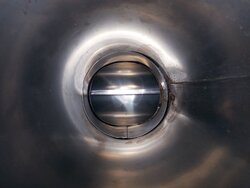Hello, I purchased a new wood stove (Englander NC-13) and opted to have the chimney professionally installed. The chimney runs out the wall and runs up the side of the house, through the sofit and through the roof. The installers did a hack job on the firestop under the sofit so I had them come back and correct it. They also used drywall screws on the finishing plate which really needed button head screws with wall anchors. Not a huge deal as its cosmetic stuff.
So I took a look into the wall thimble (Securite ASHT RSM 6) from inside the house and where it joins up with the "T" (Securite ASHT 6) there is an obvious lip inside where you can see insulation exposed. I would imagine this should be a clean unobstructed path so the flue gasses can pass with no resistance. The shop installers say this is normal. My common sense tells me otherwise and before I put my family at risk I am looking for a concrete answer. Any info would be greatly appreciated. thank you. Picture attached is taken from inside the house facing outside into the thimble. Please pay close attention to the 3 to 4 oclock region as it is where the issue lies.Thank you
So I took a look into the wall thimble (Securite ASHT RSM 6) from inside the house and where it joins up with the "T" (Securite ASHT 6) there is an obvious lip inside where you can see insulation exposed. I would imagine this should be a clean unobstructed path so the flue gasses can pass with no resistance. The shop installers say this is normal. My common sense tells me otherwise and before I put my family at risk I am looking for a concrete answer. Any info would be greatly appreciated. thank you. Picture attached is taken from inside the house facing outside into the thimble. Please pay close attention to the 3 to 4 oclock region as it is where the issue lies.Thank you



